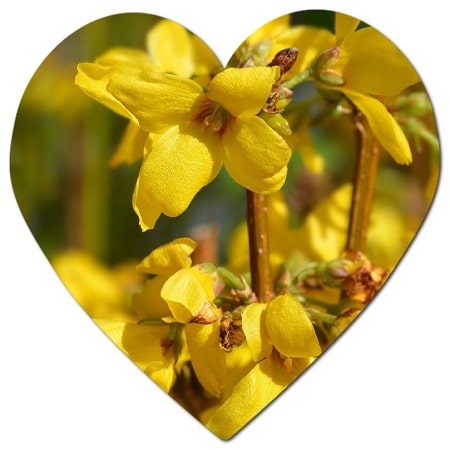Latin :Forsythia sp. Family : Forsythia intermedia Homeland : East Asia and Southeast Europe Venue : Outdoor Group : Ornamental Trees Description: The plant is one of the first heralds of spring with bell-shaped bright yellow flowers in March. The leaves appear after the flowers fall. It can be used as a hedge plant or as a single plant. Light Requirements: It grows in sunny or slightly shaded places. However, the number and quality of flowers increases in places with plenty of sun. Temperature Requirements: It is resistant to cold temperatures up to -20, -30 degrees in winter. Soil Requirements: It is not selective in terms of soil. Any garden soil with good drainage is sufficient. Irrigation: Water demand of the plant increases in summer.
Fertilization: It is the best way to analyze the garden soil where the plant will be grown and then fertilize according to the nutrient content of the soil. Pruning: The plant is suitable for pruning. However, it should not be pruned deeply. Otherwise, very few flowers will bloom the following season. At the end of spring, only the parts of the branches bearing withered flowers should be pruned. Some of the old branches can be cut from the bottom every few years to refresh the plant. Propagation: Propagated by cuttings. Diseases and Pests: Pests such as aphids, snails and slugs are most common on young shoots in spring.

Forsythia × intermedia, commonly known as Border Forsythia, is a deciduous shrub that is widely cultivated for its bright yellow flowers that appear in early spring. Here are some key characteristics of Forsythia × intermedia:
- Flowers: One of the most striking features of Forsythia × intermedia is its abundant bright yellow flowers. The flowers are usually bell-shaped and appear before the leaves in early spring. They cover the branches, creating a vibrant display.
- Leaves: The leaves are simple, opposite, and generally ovate to lanceolate in shape. They are medium to dark green and provide a nice backdrop to the yellow flowers during the growing season.
- Growth Habit: Forsythia × intermedia is a deciduous shrub with an upright and arching growth habit. It typically reaches a height of 6 to 10 feet (1.8 to 3 meters) with a similar spread.
- Branches: The branches are long, arching, and have a slightly zigzagging pattern. The flowers appear along the length of these branches.
- Fruit: After flowering, Forsythia × intermedia produces small, brown capsule-like fruits. While not particularly showy, these fruits contribute to the overall ornamental appeal.
- Bark: The bark is grayish-brown and becomes more noticeable in winter when the shrub is without leaves.
- Hardiness: Forsythia × intermedia is hardy and adaptable, thriving in a variety of soil types. It is suitable for USDA hardiness zones 5 to 8.
- Pruning: Forsythia × intermedia responds well to pruning. Pruning can be done after flowering to control its size, shape, and promote better flowering in the following year.
- Landscape Use: Often used as a specimen plant, in borders, or as a hedge, Forsythia × intermedia is a popular choice for early spring color in gardens and landscapes.
It’s important to note that there are several cultivars of Forsythia × intermedia, each with its own specific characteristics, such as size, flower color, and growth habit. When selecting a Forsythia × intermedia for your garden, consider the specific requirements and features of the chosen cultivar.
Where is the best place to plant Forsythia x intermedia?
Forsythia x intermedia, or Border Forsythia, is a popular shrub known for its vibrant yellow flowers that bloom in early spring. Here are some guidelines on the best place to plant Forsythia x intermedia:
- Sunlight: Forsythia x intermedia prefers full sun to partial shade. Plant it in a location where it can receive at least 6 hours of direct sunlight each day. This helps ensure optimal flowering.
- Soil: The shrub is adaptable to various soil types but thrives in well-draining soil. It can tolerate slightly acidic to slightly alkaline soil. Adding organic matter to the soil at the time of planting can improve its structure and fertility.
- Spacing: Provide adequate spacing between Forsythia plants. This not only allows each plant to develop its natural form but also ensures good air circulation, which can help prevent diseases.
- Air Circulation: Forsythia x intermedia benefits from good air circulation. Avoid planting it in areas where air circulation is poor, as this can contribute to the development of fungal diseases.
- Protection from Late Frosts: Since Forsythia blooms early in spring, the flowers can be susceptible to damage from late frosts. Planting in a location with some protection from late frosts, such as near a building or in a more sheltered area, can help minimize the risk of frost damage.
- Background and Visibility: Consider the background and visibility of Forsythia x intermedia. Plant it where the bright yellow flowers can stand out and provide a cheerful display, especially in early spring when few other plants may be flowering.
- Pruning Space: Forsythia x intermedia can benefit from occasional pruning to control its size and shape. When planting, consider the eventual size of the mature shrub and allow sufficient space for it to grow without becoming crowded.
- Landscaping Use: Forsythia x intermedia is often used as a specimen plant, in borders, or as a hedge. Plant it where it complements the overall design of your garden or landscaping.
Remember to water newly planted Forsythia regularly until it becomes established, and then maintain a consistent watering schedule, especially during dry periods. Following these guidelines will help ensure the healthy growth and abundant flowering of Forsythia x intermedia in your garden.
